Composition and form of release
Active ingredient: hifenadine.
Composition
- 1 tablet contains hifenadine hydrochloride 25 mg;
- excipients: potato starch, sucrose, calcium stearate.
Release form
Pills.
Pharmacological properties
Pharmacodynamics. The active substance of the drug fenkarol is a derivative of quinuclidylcarbinol, which reduces the effect of histamine on organs and systems. Hifenadine is a competitive blocker of H1 receptors. In addition, it activates the enzyme diamine oxidase, which breaks down about 30% of endogenous histamine. This explains the effectiveness of hifenadine in patients insensitive to other antihistamines. Hifenadine poorly penetrates the blood-brain barrier and has little effect on the processes of serotonin deamination in the brain, and has a weak effect on the activity of MAO. The antihistamine properties of hifenadine are associated with the presence of a cyclic quinuclidine nucleus in the structure and the distance between the diphenylcarbinol group and the nitrogen atom. In terms of antihistamine activity and duration of action, hifenadine is superior to diphenhydramine. Reduces the toxic effect of histamine, in particular eliminates or weakens its bronchoconstrictor effect and spasmolytic effect on intestinal smooth muscles, exhibits moderate antiserotonin and weak anticholinergic effects, clearly expressed antipruritic and desensitizing properties. Hifenadine reduces the hypotensive effect of histamine and its effect on capillary permeability, does not directly affect cardiac activity and blood pressure, does not have a protective effect in aconite arrhythmias.
Hifenadine does not have a depressing effect on the CNS, but with individual hypersensitivity, a weak sedative effect is possible. The drug has low lipophilicity, so its content in brain tissues is low (0.05%), which explains the lack of a depressing effect on the CNS.
Pharmacokinetics. Hifenadine is rapidly absorbed from the gastrointestinal tract and after 30 minutes the drug is administered to the tissues of the body. C max in blood plasma is achieved in 1 hour. Metabolites and unchanged hifenadine are mainly excreted in the urine, bile and are excreted by the lungs within 48 hours. Hifenadine is metabolized in the liver.
Indication
Pollinosis, food and drug allergies, other allergic diseases, acute and chronic urticaria, angioedema (angioedema), hay fever, allergic rhinopathy, dermatoses (eczema, psoriasis, neurodermatitis, skin itching), as well as infectious-allergic reactions with a bronchospastic component.
Application
Hifenadine is taken orally immediately after meals.
A single dose for adults is 25-50 mg 2-4 times a day. In case of hay fever, a daily dose of 75 mg is ineffective. The maximum daily dose is 200 mg. The duration of the course of treatment is 10-20 days.
Children over 12 years old – 25 mg 2-3 times a day. Duration of treatment – 10-20 days.
If necessary, the course of treatment is repeated.
If the next dose is missed, the course of treatment should be continued at the previously prescribed doses. If necessary, consult a doctor.
Contraindication
Hypersensitivity to hifenadine or excipients of the drug.
Side effects
From the nervous system: dizziness, headache.
Sometimes a weak sedative effect is possible, which manifests itself in the form of weakness, drowsiness, and slowing down of the body’s reactions.
On the part of the gastrointestinal tract: dryness of the mucous membranes of the oral cavity, dyspeptic phenomena (nausea, vomiting, bitterness in the mouth), which usually disappear when the dose is reduced or the drug is discontinued.
Respiratory, thoracic and mediastinal disorders: sneezing, difficulty breathing.
On the part of the psyche: anxiety.
Renal and urinary disorders: proteinuria, interstitial nephritis.
Musculoskeletal and connective tissue disorders: joint pain.
From the organ of vision: lacrimation.
In people with gastrointestinal diseases, the possibility of side effects increases.
If any side effects occur, you should stop using the drug and consult a doctor.
Special instructions
Caution should be exercised in severe diseases of the cardiovascular system, gastrointestinal tract or liver. The drug contains sucrose, which should be taken into account by patients with diabetes mellitus. Patients with rare hereditary diseases, such as fructose intolerance or sucrase-isomaltase insufficiency, should not take the drug.
Pregnancy and breastfeeding
It is contraindicated to prescribe the drug in the first trimester of pregnancy. Its use is not recommended in the second and third trimesters of pregnancy. There is no data on the penetration of the drug into breast milk, therefore the use of the drug Fenkarol during breastfeeding is contraindicated.
Children
Used in children from 12 years of age.
Drivers
Persons whose work requires rapid physical or mental reactions (vehicle drivers, etc.) should first establish individual sensitivity (by short-term administration) to the sedative effect. These persons should be especially careful.
Interactions
Hifenadine does not enhance the depressing effects of alcohol and hypnotics on the central nervous system. Fenkarol has weak m-anticholinergic properties, therefore, by reducing the motility of the gastrointestinal tract, it is able to enhance the absorption of slowly absorbed drugs (for example, indirect anticoagulants of the coumarin series).
Overdose
Daily dose up to 300 mg/day does not cause serious side effects. High doses can cause dryness of the mucous membrane, headache, epigastric pain, vomiting and other dyspeptic phenomena. There is no specific antidote. If necessary, symptomatic treatment is carried out.
Storage conditions
In a dry, dark place at a temperature not exceeding 25 °C.

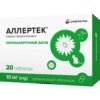
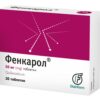



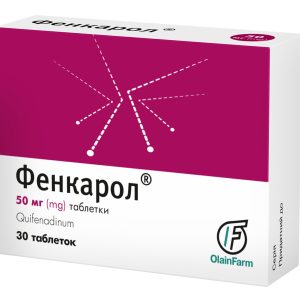
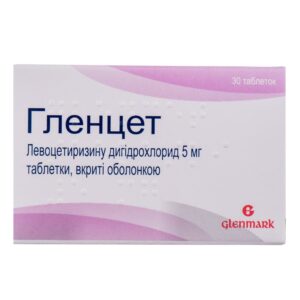
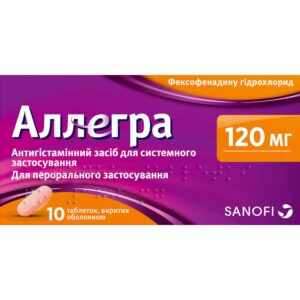
Reviews
There are no reviews yet.